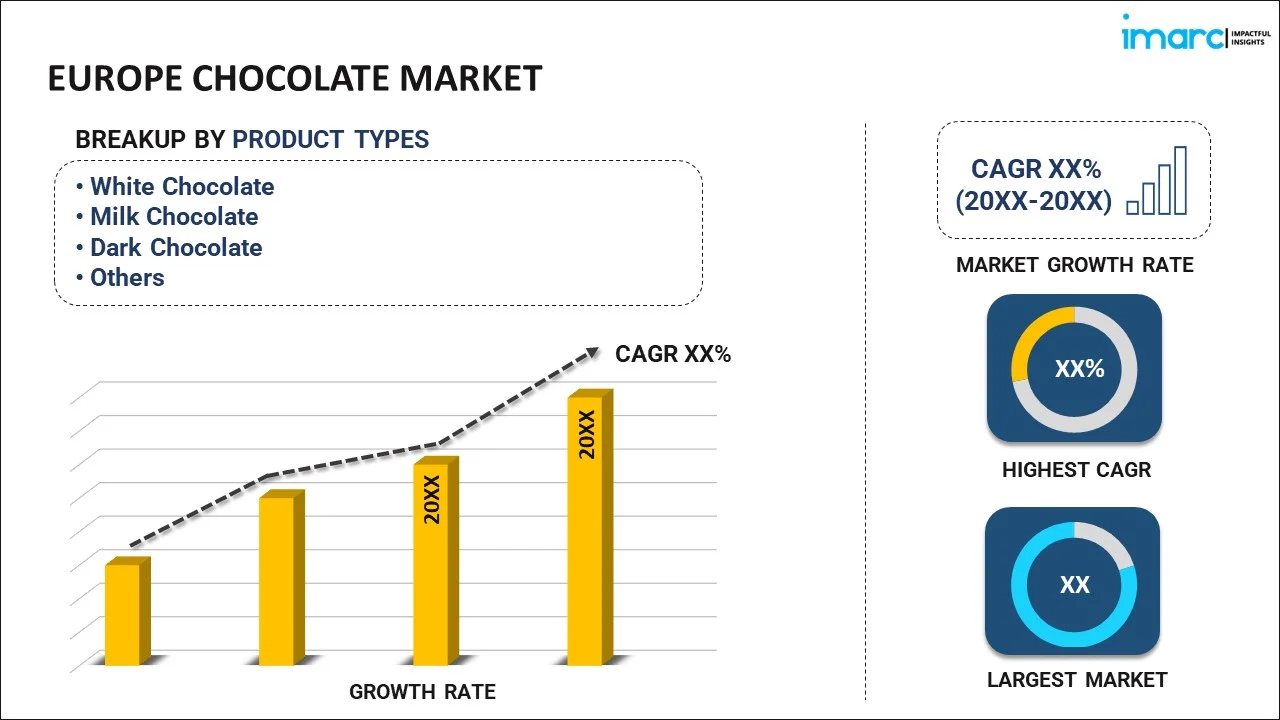IMARC made the whole process easy. Everyone I spoke with via email was polite, easy to deal with, kept their promises regarding delivery timelines and were solutions focused. From my first contact, I was grateful for the professionalism shown by the whole IMARC team. I recommend IMARC to all that need timely, affordable information and advice. My experience with IMARC was excellent and I can not fault it.
Read More
Europe Chocolate Market Report by Product Type (White Chocolate, Milk Chocolate, Dark Chocolate, and Others), Product Form (Molded, Countlines, and Others), Application (Food Products, Beverages, and Others), Pricing (Everyday Chocolate, Premium Chocolate, Seasonal Chocolate), Distribution (Direct Sales (B2B), Supermarkets and Hypermarkets, Convenience Stores, Online Stores, and Others), and Country 2025-2033
Market Overview:
The Europe chocolate market size reached USD 77.7 Billion in 2024. Looking forward, IMARC Group expects the market to reach USD 111.0 Billion by 2033, exhibiting a growth rate (CAGR) of 4% during 2025-2033. The growing proliferation of e-commerce platforms fostering direct-to-consumer (D2C) channels and personalized shopping experiences, increasing automation and innovative manufacturing techniques to streamline production processes, and rising number of producers leveraging social media marketing represent some of the key factors driving the market.
|
Report Attribute
|
Key Statistics
|
|---|---|
|
Base Year
|
2024
|
|
Forecast Years
|
2025-2033
|
|
Historical Years
|
2019-2024
|
|
Market Size in 2024
|
USD 77.7 Billion |
|
Market Forecast in 2033
|
USD 111.0 Billion |
| Market Growth Rate 2025-2033 | 4% |
Chocolate is a product derived from cacao beans, the seeds of the cacao tree, and manufactured by harvesting, fermenting, drying, roasting, grinding, and conching the cacao beans. It is available as dark chocolate, which possesses a higher cocoa content and limited sugar and offers a deep, complex flavor profile. It is also available as milk chocolate and white chocolate, which is made from cocoa butter, sugar, and milk solids and has a subtly sweet and butter-like flavor. It contains antioxidants, including flavonoids that can help combat oxidative stress and inflammation. It also consists of flavanols which are linked to improved heart health by promoting healthy blood circulation and potentially reducing the risk of heart disease. It includes compounds like phenylethylamine and anandamide, which can trigger the release of endorphins, enhancing mood and potentially alleviating stress. Chocolate comprises essential minerals, such as magnesium, iron, and copper, which contribute to overall health and well-being. It can blend seamlessly with other ingredients, enhancing flavors and textures. It is used to prepare various culinary food products, including desserts, pastries, beverages, and savory dishes. Furthermore, as chocolate is widely utilized for garnishes, decorations, and artistic presentations of various dishes, its demand is increasing in Europe.
Europe Chocolate Market Trends:
At present, the increasing demand for premium and artisanal chocolate containing natural ingredients, reduced sugar content, and enhanced nutritional profiles represents one of the major factors influencing the market positively in Europe. Moreover, the rising demand for ethically sourced and sustainable chocolate products, compelling manufacturers to embrace transparent supply chains and environmentally responsible practices, is strengthening the market growth in the region. Apart from this, the growing proliferation of e-commerce platforms fostering direct-to-consumer (D2C) channels and personalized shopping experiences is offering a positive market outlook in Europe. Additionally, the rising automation and innovative manufacturing techniques to streamline production processes, enhance product consistency, and potentially reduce costs are offering lucrative growth opportunities to industry investors in the region. In line with this, the increasing number of producers leveraging social media and interactive marketing to engage consumers and craft immersive brand narratives is impelling the market growth. Besides this, the rising popularity of dark chocolate, driven by its perceived health benefits and premium associations, is propelling the growth of the market in Europe. In addition, the increasing demand for convenience-oriented packaging and portion-controlled products is bolstering the growth of the market. Furthermore, rising collaborations between chocolate manufacturers and renowned chefs or ingredients suppliers to manufacture various limited-edition and luxury chocolate ranges that cater to sophisticated palates is contributing to the growth of the market in Europe.
Europe Chocolate Market Segmentation:
IMARC Group provides an analysis of the key trends in each segment of the Europe chocolate market report, along with forecasts at the regional and country levels for 2025-2033. Our report has categorized the market based on product type, product form, application, pricing, and distribution.
Product Type Insights:

- White Chocolate
- Milk Chocolate
- Dark Chocolate
- Others
The report has provided a detailed breakup and analysis of the market based on the product type. This includes white chocolate, milk chocolate, dark chocolate, and others.
Product Form Insights:
- Molded
- Countlines
- Others
A detailed breakup and analysis of the market based on the product form has also been provided in the report. This includes molded, countlines, and others.
Application Insights:
- Food Products
- Bakery Products
- Sugar Confectionery
- Desserts
- Others
- Beverages
- Others
A detailed breakup and analysis of the market based on the application has also been provided in the report. This includes food products (bakery products, sugar confectionery, desserts, and others), beverages, and others.
Pricing Insights:
- Everyday Chocolate
- Premium Chocolate
- Seasonal Chocolate
A detailed breakup and analysis of the market based on the pricing has also been provided in the report. This includes everyday chocolate, premium chocolate, and seasonal chocolate.
Distribution Insights:
- Direct Sales (B2B)
- Supermarkets and Hypermarkets
- Convenience Stores
- Online Stores
- Others
A detailed breakup and analysis of the market based on the distribution has also been provided in the report. This includes direct sales (B2B), supermarkets and hypermarkets, convenience stores, online stores, and others.
Country Insights:
- Germany
- France
- United Kingdom
- Italy
- Spain
- Others
The report has also provided a comprehensive analysis of all the major regional markets, which include Germany, France, the United Kingdom, Italy, Spain, and others.
Competitive Landscape:
The report has also provided a comprehensive analysis of the competitive landscape in the market. Competitive analysis such as market structure, key player positioning, top winning strategies, competitive dashboard, and company evaluation quadrant has been covered in the report. Also, detailed profiles of all major companies have been provided.
Europe Chocolate Market Report Coverage:
| Report Features | Details |
|---|---|
| Base Year of the Analysis | 2024 |
| Historical Period | 2019-2024 |
| Forecast Period | 2025-2033 |
| Units | Billion USD |
| Scope of the Report | Exploration of Historical and Forecast Trends, Industry Catalysts and Challenges, Segment-Wise Historical and Predictive Market Assessment:
|
| Product Types Covered | White Chocolate, Milk Chocolate, Dark Chocolate, Others |
| Product Forms Covered | Molded, Countlines, Others |
| Applications Covered |
|
| Pricings Covered | Everyday Chocolate, Premium Chocolate, Seasonal Chocolate |
| Distributions Covered | Direct Sales (B2B), Supermarkets and Hypermarkets, Convenience Stores, Online Stores, Others |
| Countries Covered | Germany, France, United Kingdom, Italy, Spain, Others |
| Customization Scope | 10% Free Customization |
| Post-Sale Analyst Support | 10-12 Weeks |
| Delivery Format | PDF and Excel through Email (We can also provide the editable version of the report in PPT/Word format on special request) |
Key Questions Answered in This Report:
- How has the Europe chocolate market performed so far and how will it perform in the coming years?
- What has been the impact of COVID-19 on the Europe chocolate market?
- What is the breakup of the Europe chocolate market on the basis of product type?
- What is the breakup of the Europe chocolate market on the basis of product form?
- What is the breakup of the Europe chocolate market on the basis of application?
- What is the breakup of the Europe chocolate market on the basis of pricing?
- What is the breakup of the Europe chocolate market on the basis of distribution?
- What are the various stages in the value chain of the Europe chocolate market?
- What are the key driving factors and challenges in the Europe chocolate market?
- What is the structure of the Europe chocolate market and who are the key players?
- What is the degree of competition in the Europe chocolate market?
Key Benefits for Stakeholders:
- IMARC’s report offers a comprehensive quantitative analysis of various market segments, historical and current market trends, market forecasts, and dynamics of the Europe chocolate market from 2019-2033.
- The research study provides the latest information on the market drivers, challenges, and opportunities in the Europe chocolate market.
- Porter's five forces analysis assist stakeholders in assessing the impact of new entrants, competitive rivalry, supplier power, buyer power, and the threat of substitution. It helps stakeholders to analyze the level of competition within the Europe chocolate industry and its attractiveness.
- Competitive landscape allows stakeholders to understand their competitive environment and provides an insight into the current positions of key players in the market.
Need more help?
- Speak to our experienced analysts for insights on the current market scenarios.
- Include additional segments and countries to customize the report as per your requirement.
- Gain an unparalleled competitive advantage in your domain by understanding how to utilize the report and positively impacting your operations and revenue.
- For further assistance, please connect with our analysts.

Benefits of Customization
Personalize this research
Triangulate with your data
Get data as per your format and definition
Gain a deeper dive into a specific application, geography, customer, or competitor
Any level of personalization
Get in Touch With Us
UNITED STATES
Phone: +1-631-791-1145
INDIA
Phone: +91-120-433-0800
UNITED KINGDOM
Phone: +44-753-714-6104
Email: sales@imarcgroup.com
 Inquire Before Buying
Inquire Before Buying Speak to an Analyst
Speak to an Analyst  Request Brochure
Request Brochure  Request Customization
Request Customization



.webp)




.webp)












